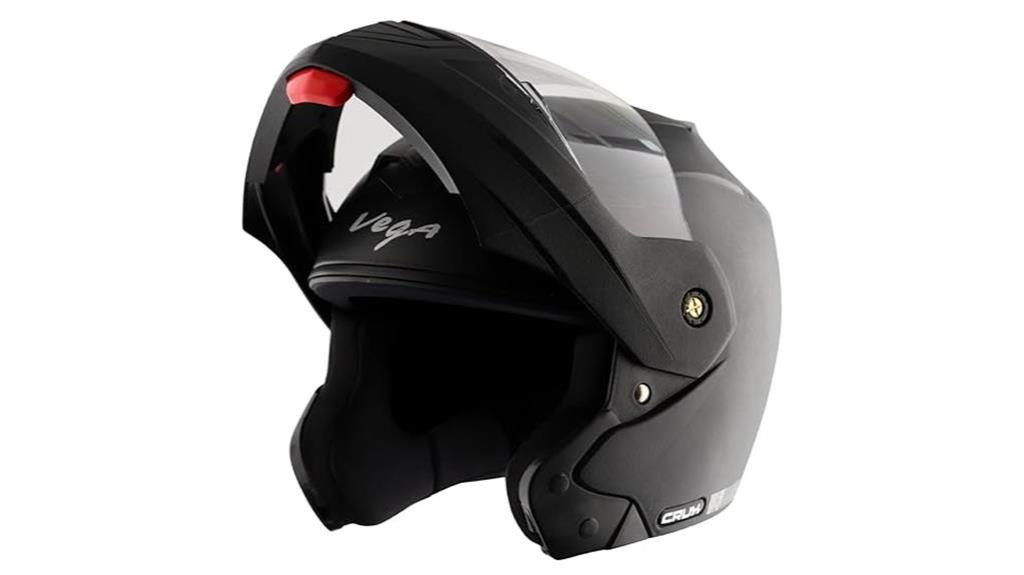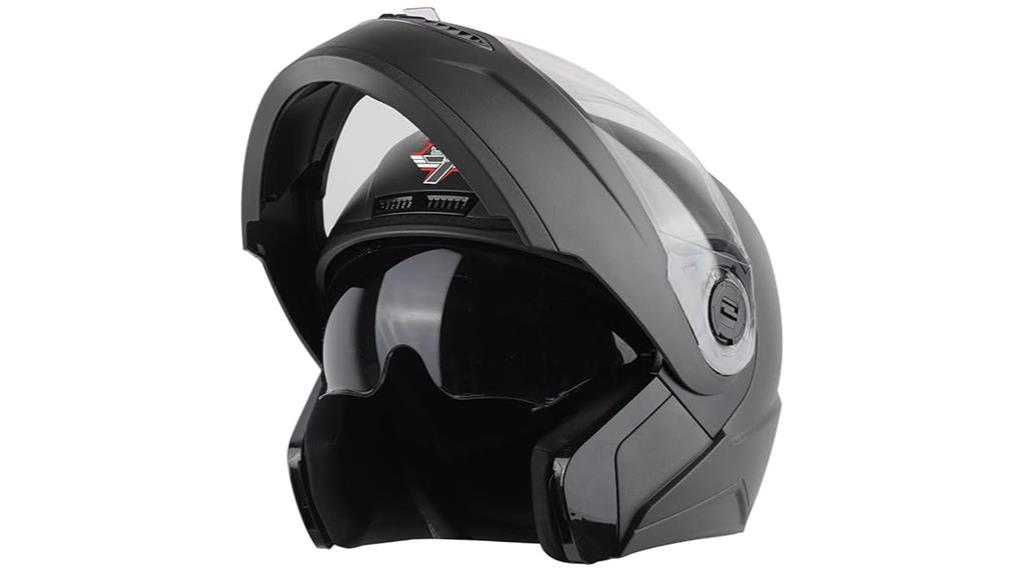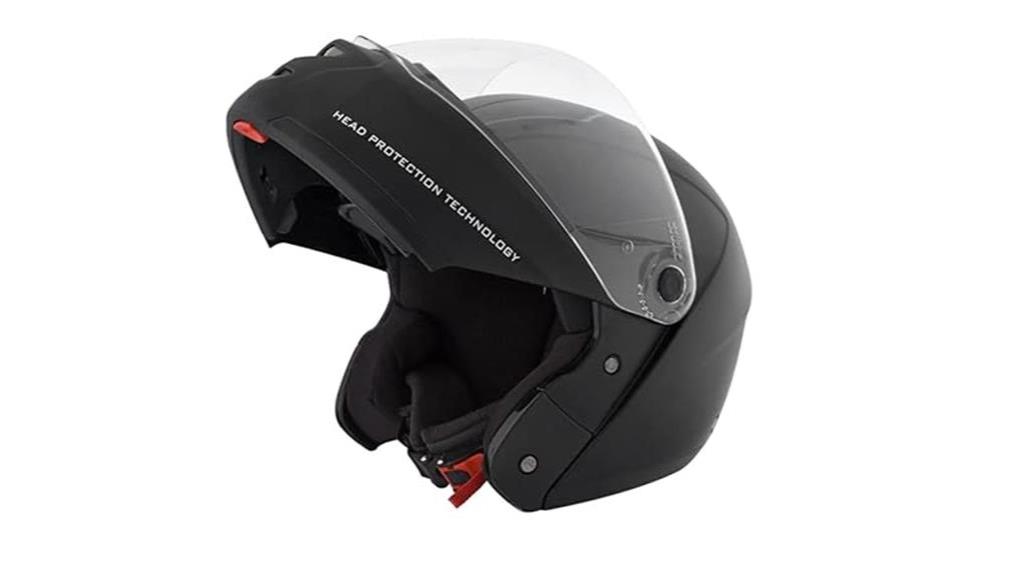Best Modular Helmet
Keep reading to discover the top three modular helmets of 2024 that perfectly combine safety and versatility for every rider’s needs.
If you’re looking for the best modular helmets of 2024 that blend safety and versatility, I recommend checking out the Vega Crux ISI Certified Flip-Up Helmet, the Steelbird SBA-7 7Wings, and the Studds Ninja Elite Full Face Helmet. Each offers high-impact protection, great comfort, and innovative features like lightweight designs and effective ventilation. The Vega Crux is perfect for a lightweight ride, while the Steelbird provides breathability during long journeys. Studds is ideal for those who prioritize clear visibility. Keep on exploring to find out more about what makes these helmets stand out!
Table of Contents
Which Is the Best Modular Helmet
Here are my top picks for the best modular helmet you can consider this year.
Vega Crux ISI Certified Flip-Up Helmet for Men and Women

If you’re looking for a reliable and stylish helmet that caters to both men and women, the Vega Crux ISI Certified Flip-Up Helmet stands out in the crowded market of modular helmets for 2024. This helmet, with its high-impact ABS shell, combines safety and comfort effortlessly. Weighing around 1.1 kg, it features a clear, scratch-resistant visor that’s also UV resistant. I love the moveable chin guard, which operates with a single lever flip-up mechanism, making it easy to use. The removable and washable lining keeps it fresh, while the metallic quick-release buckle ensures secure fastening. With a customer rating of 4.2 stars, it’s clear that many riders appreciate its quality and fit. Overall, it’s a solid choice for both motorcycling and off-road biking.
Best For: Riders looking for a versatile and comfortable helmet suitable for both casual motorcycling and off-road biking.
Pros:
- High-impact ABS shell provides excellent safety and durability.
- Removable and washable lining ensures easy maintenance and freshness.
- Single lever flip-up chin guard allows for convenient use and accessibility.
Cons:
- Some users report that the weight may cause neck pain during extended use.
- Limited stain resistance may require careful handling to maintain appearance.
- Size availability may be restricted for those needing larger or smaller options.
Steelbird SBA-7 7Wings Flip-Up Helmet for Men and Women

The Steelbird SBA-7 7Wings Flip-Up Helmet is an excellent choice for both men and women who value comfort and safety during their rides. With its Italian design, it features a hygienic interior and a high impact-resistant shell made from thermoplastic. Weighing just 1.76 kg, it’s comfortable for long journeys, thanks to the breathable padding and neck protector.
I particularly appreciate the multi-pore ventilation design, which keeps me cool in hot weather. The flip mechanism allows easy access, and the inner smoke sun shield is a handy addition. Customers rate it 4.2 out of 5 stars, praising its durability and fit. However, some users reported issues with the sun visor effectiveness and fitting certain scooter models. Overall, it’s a solid choice for riders.
Best For: Riders seeking a comfortable, durable, and stylish helmet suitable for both men and women.
Pros:
- Sturdy fastening buckle ensures secure fit.
- Wide field of view enhances visibility on the road.
- Anti-scratch finish maintains visor clarity over time.
Cons:
- Front opening/closing mechanism may wear over time.
- Inner sun visor coverage could be improved.
Studds Ninja Elite Full Face Helmet (Black)

Looking for a reliable helmet that offers both comfort and robust protection? The Studds Ninja Elite Full Face Helmet in black checks all the boxes. Weighing in at just 480 grams, it features a high-impact engineering thermoplastic outer shell that ensures durability. The optically true visor is scratch-resistant, providing crystal-clear visibility. Inside, you’ll find regulated density EPS and anti-allergic velveteen padding for added comfort. Users recommend this helmet for speeds over 35 km/h, emphasizing its protective qualities. However, I’d suggest ordering one size larger due to some sizing quirks. With a solid customer rating of 4.2 out of 5 stars, it’s clear this helmet is a popular choice among riders. Overall, it’s a fantastic blend of safety and functionality.
Best For: Riders seeking a comfortable and protective full-face helmet for motorcycling at speeds over 35 km/h.
Pros:
- Durable outer shell made from high-impact engineering thermoplastic.
- Comfortable inner padding with anti-allergic velveteen for a pleasant wearing experience.
- Scratch-resistant visor that provides clear visibility while riding.
Cons:
- Sizing issues may require purchasing one size larger than usual.
- Mixed feedback on design aesthetics, which may not appeal to everyone.
- Weight of 480 grams might feel heavy to some riders over extended use.
Factors to Consider When Choosing a Modular Helmet
When I choose a modular helmet, I always consider several key factors to ensure I make the right decision. Safety certifications and the durability of the shell material are crucial, but I also pay attention to weight, comfort, and ventilation features. Lastly, the quality of the visor can really make a difference in protection and visibility on the road.
Safety Certifications and Standards
Choosing a modular helmet can feel overwhelming, especially with the variety of safety certifications available. It’s essential to understand what these certifications mean to ensure you’re making a safe choice. For instance, in India, the ISI certification under IS 4151:2015 guarantees that a helmet meets specific safety standards and performance criteria. This certification involves rigorous testing for impact resistance, penetration resistance, and retention system effectiveness, ensuring the helmet can withstand accidents.
Additionally, international standards like DOT (Department of Transportation) and ECE (Economic Commission for Europe) are critical benchmarks to look for. Helmets that comply with these standards indicate reliability in various riding conditions.
Always check for the certification mark on the helmet before purchasing. This mark confirms that the helmet has passed the necessary safety tests and is fit for use on the roads. Remember, investing in a certified helmet is not just about comfort and style; it’s about your safety, too. So, take the time to verify these certifications, and you’ll feel more confident in your choice. Safety should always be a priority when hitting the road on your motorcycle.
Shell Material Durability
While considering a modular helmet, the durability of the shell material is a key factor that can’t be overlooked. I’ve learned that high-impact ABS (Acrylonitrile Butadiene Styrene) is a popular choice among manufacturers, thanks to its resilience against collisions. When I’m choosing a helmet, I prioritize those made from thermoplastic materials like EPS (Expanded Polystyrene) and ABS. They provide excellent impact resistance while remaining lightweight, which is crucial for comfort during long rides.
The quality of the outer shell determines its ability to withstand abrasions and impacts. I always look for helmets that have undergone rigorous testing to meet safety standards. A well-constructed shell not only enhances durability but also boosts aerodynamic performance, which helps reduce drag and improve stability at higher speeds.
I’ve found that regular maintenance and proper storage are essential for extending the lifespan of a helmet’s shell. It’s important to inspect my gear frequently for any signs of wear or damage. By keeping an eye on these factors, I can ensure my helmet remains reliable and protective on every ride.
Weight and Comfort
After ensuring the durability of the shell material, the next factor I consider is the weight and comfort of the modular helmet. The weight can significantly impact my overall experience, especially on long rides. I’ve found that helmets typically weigh between 1.1 kg and 1.8 kg; opting for lighter models can help reduce neck strain over time.
Equally important is the helmet’s design and padding materials. I pay close attention to how the weight is distributed across my head and neck, as a well-balanced helmet feels much more comfortable. I also prefer helmets with removable and washable linings, which help maintain hygiene, especially during extended use.
While I’m aware that ventilation features can contribute to comfort, I focus on finding a helmet that fits well first. Trying on different sizes and shapes ensures the helmet sits securely without being overly tight or heavy. A proper fit is essential for comfort on long journeys, and I’ve learned that every detail counts in achieving the perfect balance between weight and comfort.
Ventilation Design Features
Effective ventilation design is one of the top three factors I consider when selecting a modular helmet. It’s essential for keeping airflow consistent, which helps regulate temperature and reduces sweat build-up during rides. I always look for helmets that feature multi-pore ventilation systems; these enhance airflow and provide comfort, especially in hot weather.
A good ventilation system should have strategically placed vents that I can adjust to control the amount of air entering the helmet. This flexibility significantly improves my riding experience, allowing me to customize my comfort level. Additionally, I appreciate helmets with removable and washable liners, as they contribute to better hygiene and comfort by allowing me to clean away sweat and odors regularly.
When evaluating a helmet, I also consider the placement and size of vents. The overall shape of the helmet plays a critical role as well, ensuring optimal aerodynamic performance and reduced drag. By prioritizing these ventilation design features, I can enjoy longer, more comfortable rides without feeling overheated or uncomfortable.
Visor Quality and Protection
When choosing a modular helmet, the quality of the visor is crucial for both safety and comfort. I always look for visors made from scratch-resistant optical polycarbonate. This material not only ensures clear visibility but also stands up to impacts, making it a solid choice for any rider.
Another important factor is UV protection. I want to shield my eyes from harmful sun rays, especially during long rides. A good visor design should also provide a wide field of view, which enhances my peripheral vision and overall safety on the road.
I can’t stress enough the importance of an anti-fog coating or ventilation options. When riding in varying weather, fogging can really compromise visibility, so I prefer helmets that prioritize clear sightlines.
Lastly, I appreciate modular helmets that come with interchangeable visors. This feature allows me to customize my protection based on different riding environments and my personal preferences. Whether I’m commuting or hitting the open road, having the right visor makes all the difference in ensuring a safe and enjoyable ride.
Closure Mechanism Reliability
While selecting a modular helmet, the reliability of the closure mechanism is something I prioritize highly. A robust closure system, often featuring metallic quick release buckles, ensures a secure fit while making it easy to remove the helmet when needed. I want to feel confident that my helmet won’t accidentally open during a ride, especially at high speeds or in the event of an accident.
I also pay attention to how smoothly the flip-up mechanism operates. A well-designed system should allow the chin guard to be raised and lowered effortlessly without compromising the helmet’s structural integrity. It’s essential that this function feels intuitive and seamless, as I don’t want to struggle with it mid-ride.
User feedback is invaluable, too. I look for insights about how the closure mechanism performs over time since some systems may wear out or lose effectiveness. Selecting a helmet with a proven track record of durability and high user satisfaction regarding its closure mechanism enhances my overall confidence and safety on the road. Trust me, investing time in this aspect pays off significantly in the long run.
Size and Fit Options
Finding the right size and fit for a modular helmet is crucial for both comfort and safety. To start, I always measure my head circumference accurately; this helps determine the correct helmet size since most helmets are designed for specific size ranges. It’s important to note that modular helmets come in different shapes—like round oval and intermediate oval—which can significantly affect how comfortable the helmet feels based on my head shape.
When I try on a helmet, I make sure it fits snugly without creating pressure points. A proper fit not only enhances comfort but also improves safety during my rides. I also look for adjustable features, such as padding or internal liners, which allow me to customize the fit for added comfort and security.
Lastly, I keep in mind that sizing can vary between brands, so I always refer to the specific size chart provided by the manufacturer. By taking these factors into account, I can ensure that I choose a modular helmet that not only fits well but also offers the protection I need on the road.
Commonly Asked Questions
What Materials Are Commonly Used in Modular Helmet Construction?
When I look at modular helmets, I notice they’re often made from materials like polycarbonate, fiberglass, and carbon fiber. These choices provide a balance of strength, weight, and comfort, enhancing both safety and versatility during rides.
How Do I Properly Maintain My Modular Helmet?
I always clean my modular helmet with mild soap and water, avoiding harsh chemicals. I inspect the visor and padding regularly, and I store it in a cool, dry place to keep it in top condition.
Are Modular Helmets Suitable for All Weather Conditions?
I’ve found modular helmets quite versatile for various weather conditions. When it’s hot, I can open the front; in rain, the visor keeps water out. Just remember to check ventilation and seal properly for the best experience.
Can I Wear Glasses With a Modular Helmet?
Absolutely, I wear glasses with my modular helmet all the time. The design allows for enough space, so I don’t feel cramped. Just make sure your helmet fits well for maximum comfort and protection.
What Is the Lifespan of a Modular Helmet?
I’ve found that the lifespan of a modular helmet typically ranges from three to five years, depending on usage and maintenance. Always check for signs of damage, as that can shorten its effective life.
My Final Opinion
In conclusion, choosing the right modular helmet can significantly enhance your riding experience while ensuring safety and comfort. The Vega Crux, Steelbird SBA-7, and Studds Ninja Elite are all excellent options that cater to different preferences and needs. Ultimately, it’s about finding the perfect balance between style, functionality, and protection. So, whether you’re commuting or embarking on a weekend adventure, make sure you invest in a helmet that fits you well and meets your safety standards.
